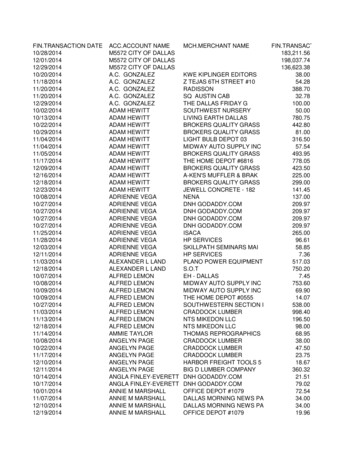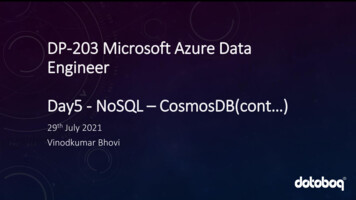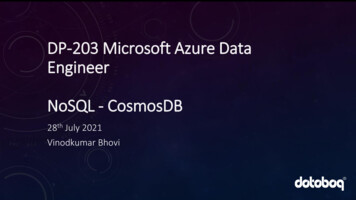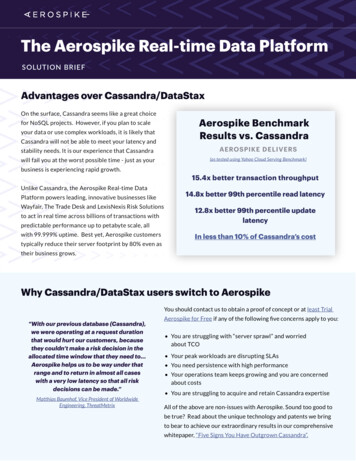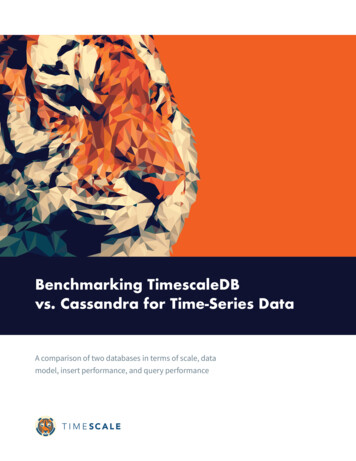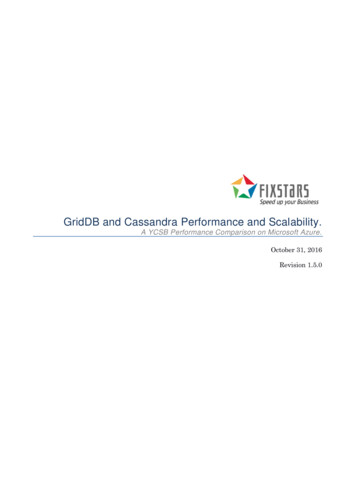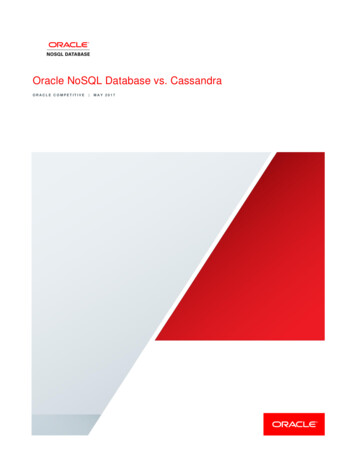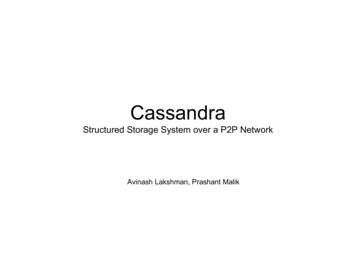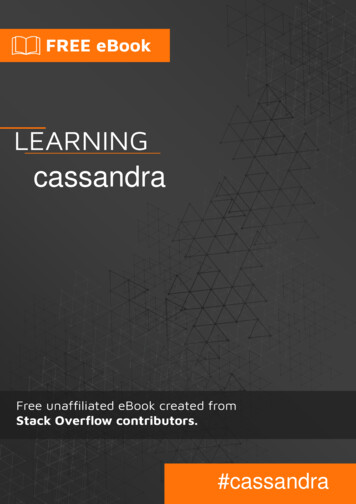
Transcription
cassandra#cassandra
Table of ContentsAbout1Chapter 1: Getting started with cassandra2Remarks2Versions3Examples5Installation or Setup5Single node Installation51. Installing a Debian package (installs Cassandra as a service)62. Installing any version of Cassandra in form of binary tarball (installs Cassandra as a6Multi node installation7Multi DC Cluster Installation7Chapter 2: Cassandra - PHP8ExamplesSimple console applicationChapter 3: Cassandra as a 0Chapter 4: Cassandra keysExamples1212Partition key, clustering key, primary key12The PRIMARY KEY syntax12Declaring a key12Examples12Syntax summary13Key ordering and allowed queriesChapter 5: Connecting to Cassandra1315Remarks15Examples15
Java: Include the Cassandra DSE Driver15Java: Connect to a Local Cassandra Instance15Java: Connect Using a Singleton16Chapter 6: Repairs in Cassandra18Parameters18Remarks18Examples19Examples for running Nodetool RepairChapter 7: Running Repair on Cassandra1922Syntax22Parameters22Examples24Running repair on Cassandra24Run repair on a particular partition range.24Run repair on the whole cluster.24Run repair in parallel mode.24Chapter 8: SecurityRemarksCassandra security resourcesExamplesConfiguring internal authentication(Optional) Replace default superuser with custom userConfiguring internal authorizationCredits2525252525262628
AboutYou can share this PDF with anyone you feel could benefit from it, downloaded the latest versionfrom: cassandraIt is an unofficial and free cassandra ebook created for educational purposes. All the content isextracted from Stack Overflow Documentation, which is written by many hardworking individuals atStack Overflow. It is neither affiliated with Stack Overflow nor official cassandra.The content is released under Creative Commons BY-SA, and the list of contributors to eachchapter are provided in the credits section at the end of this book. Images may be copyright oftheir respective owners unless otherwise specified. All trademarks and registered trademarks arethe property of their respective company owners.Use the content presented in this book at your own risk; it is not guaranteed to be correct noraccurate, please send your feedback and corrections to info@zzzprojects.comhttps://riptutorial.com/1
Chapter 1: Getting started with cassandraRemarksThe Apache Cassandra database is the right choice when you need scalability and highavailability without compromising performance. Linear scalability and proven fault-tolerance oncommodity hardware or cloud infrastructure make it the perfect platform for mission-critical data.Cassandra's support for replicating across multiple datacenters is best-in-class, providing lowerlatency for your users and the peace of mind of knowing that you can survive regional outages.PROVENCassandra is in use at Constant Contact, CERN, Comcast, eBay, GitHub, GoDaddy, Hulu,Instagram, Intuit, Netflix, Reddit, The Weather Channel, and over 1500 more companies that havelarge, active data sets.FAULT TOLERANTData is automatically replicated to multiple nodes for fault-tolerance. Replication across multipledata centers is supported. Failed nodes can be replaced with no downtime.PERFORMANTCassandra consistently outperforms popular NoSQL alternatives in benchmarks and realapplications, primarily because of fundamental architectural choices.DECENTRALIZEDThere are no single points of failure. There are no network bottlenecks. Every node in the clusteris identical.SCALABLESome of the largest production deployments include Apple's, with over 75,000 nodes storing over10 PB of data, Netflix (2,500 nodes, 420 TB, over 1 trillion requests per day), Chinese searchengine Easou (270 nodes, 300 TB, over 800 million reqests per day), and eBay (over 100 nodes,250 TB).DURABLECassandra is suitable for applications that can't afford to lose data, even when an entire datacenter goes down.YOU'RE IN CONTROLChoose between synchronous or asynchronous replication for each update. Highly availableasynchronous operations are optimized with features like Hinted Handoff and Read Repair.https://riptutorial.com/2
ELASTICRead and write throughput both increase linearly as new machines are added, with no downtimeor interruption to applications.PROFESSIONALLY SUPPORTEDCassandra support contracts and services are available from third parties.VersionsVersionRelease 09-18https://riptutorial.com/3
VersionRelease 9https://riptutorial.com/4
VersionRelease .30042016-08-10(Got this using a bit of awk: gitlog --tags --simplify-by-decoration --pretty "format:%ai %d" egrep "\(tag: [0-9]" awk -F" " '{ print 1 " " 5}' awk -F"." '{print 1 "." 2 "." 3}' awk-F" " '{print 2 " " 1}' sed 's/)//' sed 's/,//' sort -n sort -u -t" " -k1,1 awk '{print" " 0 " "}')ExamplesInstallation or SetupSingle node Installation1. Pre-install NodeJS, Python and Javahttps://riptutorial.com/5
2. Select your installation document based on your cassandra/install/installTOC.html3. Download Cassandra binaries from http://cassandra.apache.org/download/4. Untar the downloaded file to installation location 5. Start the cassandra using installation location /bin/cassandra OR start Cassandra as aservice - [sudo] service cassandra start6. Check whether cassandra is up and running using installation location /bin/nodetoolstatus.Ex:1. On Windows environment run cassandra.bat file to start Cassandra server and cqlsh.bat toopen CQL client terminal to execute CQL commands.There are two ways that installation for a Single Node can be carried out.You should have Oracle Java 8 or OpenJDk 8 (preferred for Cassandra versions 3.0)1. Installing a Debian package (installs Cassandra as a service)Add the Cassandra version to the repository (replace the 22x with your own version for examplefor 2.7 use 27x)echo "deb-src http://www.apache.org/dist/cassandra/debian 22x main" sudo tee -a/etc/apt/sources.list.d/cassandra.sources.list# Update the repositorysudo apt-get update# Then install itsudo apt-get install cassandra cassandra-toolsNow Cassandra can be started and stopped using:sudo service cassandra startsudo service cassandra stopCheck the status using:nodetool statusLogs and Data directories are /var/log/cassandra and /var/lib/cassandra respectively.2. Installing any version of Cassandra in form of binary tarball (installsCassandra as a standalone process)Download the Datastax version:curl ssandra-version number-bin.tar.gz tarhttps://riptutorial.com/6
Or Apache Cassandra binary tarball manually (from the sitehttp://www.apache.org/dist/cassandra/)Now untar this:tar -xvzf dsc-cassandra-version number-bin.tar.gzChange the directory to install location:cd install locationStart Cassandra using:sudo sh ./bin/cassandraStop using:sudo kill -9 pidCheck:./bin/nodetool statusAnd viola, you have a single-node test cluster for Cassandra. So just use cqlsh in the terminal forCassandra shell.Configuration of Cassandra can be done in cassandra.yaml in conf folder in install location.Multi node installationMulti DC Cluster InstallationRead Getting started with cassandra online: ngstarted-with-cassandrahttps://riptutorial.com/7
Chapter 2: Cassandra - PHPExamplesSimple console applicationDownload the Datastax PHP driver for Apache Cassandra from the Git project site, and follow theinstallation instructions.We will be using the "users" table from the KillrVideo app and the Datastax PHP driver. Onceyou have Cassandra up and running, create the following keyspace and table://Create the keyspaceCREATE KEYSPACE killrvideo WITH REPLICATION { 'class' : 'SimpleStrategy', 'replication factor' : 1 };//Use the keyspaceUSE killrvideo;// Users keyed by idCREATE TABLE users (userid uuid,firstname text,lastname text,email text,created date timestamp,PRIMARY KEY (userid));Create a PHP file with your favorite editor. First, we need to connect to our “killrvideo” keyspaceand cluster:build(); keyspace 'killrvideo'; session cluster- connect( keyspace);Let’s insert a user into the “users” table:execute(new Cassandra\SimpleStatement("INSERT INTO users (userid, created date, email, firstname, lastname)VALUES (14c532ac-f5ae-479a-9d0a-36604732e01d, '2013-01-01 Using the Datastax PHP Cassandra driver, we can query the user by userid:execute(new Cassandra\SimpleStatement("SELECT firstname, lastname, email FROM killrvideo.usersWHERE userid 14c532ac-f5ae-479a-9d0a-36604732e01d"));foreach ( result as row) {https://riptutorial.com/8
printf("user: \"%s\" \"%s\" email: \"%s\" \n", row['firstname'], row['lastname'], row['email']);}For a user to update their email address in the system:execute(new Cassandra\SimpleStatement("UPDATE users SET email 'language evangelist@example.com'WHERE userid w Cassandra\SimpleStatement("SELECT firstname, lastname, email FROM killrvideo.usersWHERE userid 14c532ac-f5ae-479a-9d0a-36604732e01d"));foreach ( result as row) {printf("user: \"%s\" \"%s\" email: \"%s\" \n", row['firstname'], row['lastname'], row['email']);}Delete the user from the table and output all of the rows. You’ll notice that the user's informationno longer comes back after being deleted:execute(new Cassandra\SimpleStatement("DELETE FROM users WHERE userid w Cassandra\SimpleStatement("SELECT firstname, lastname, email FROM killrvideo.usersWHERE userid 14c532ac-f5ae-479a-9d0a-36604732e01d"));foreach ( result as row) {printf("user: \"%s\" \"%s\" email: \"%s\" \n", row['firstname'], row['lastname'], row['email']);}The output should look something like this:user: "Luke" "Tillman" email: "luke@example.com"user: "Luke" "Tillman" email: "language evangelist@example.com"References:Getting Started with Apache Cassandra and PHP, DataStax AcademyRead Cassandra - PHP online: ndra---phphttps://riptutorial.com/9
Chapter 3: Cassandra as a ServiceIntroductionThis topic describes how to start Apache Cassandra as a service in windows and linux platforms.Remember you also start Cassandra from bin directory by running the batch or shell script.ExamplesWindows1. Download the latest apache commons daemon from Apache Commons Project Distributions.2. Extract the commons daemon in Cassandra installed directory \bin.3. Rename the extracted folder as daemon.4. Add Cassandra installed directory as CASSANDRA HOME in windows environmentvariable.5. Edit the cassandra.yaml file in Cassandra installed directory \conf and uncomment thedata file directories, commitlog directory, saved cache directory and set the absolutepaths.6. Edit cassandra.bat in Cassandra installed directory \bin and replace the value for thePATH PRUNSRV as follows:for 32 bit windows, set PATH PRUNSRV %CASSANDRA HOME%\bin\daemon\for 64 bit windows, set PATH PRUNSRV %CASSANDRA HOME%\bin\daemon\amd64\7. Edit cassandra.bat and configure SERVICE JVM for required service name.SERVICE JVM "cassandra"8. With administrator privileges, run cassandra.bat install from command prompt.Linux1. Create the /etc/init.d/cassandra startup script.2. Edit the contents of the file:#!/bin/sh## chkconfig: - 80 45# description: Starts and stops Cassandra# update daemon path to point to the cassandra executablehttps://riptutorial.com/10
DAEMON Cassandra installed directory /bin/cassandrastart() {echo -n "Starting Cassandra. " DAEMON -p /var/run/cassandra.pidecho "OK"return 0}stop() {echo -n "Stopping Cassandra. "kill (cat /var/run/cassandra.pid)echo "OK"return 0}case " 1" o "Usage: 0 {start stop restart}"exit 1esacexit ?3. Make the file executable:sudo chmod x /etc/init.d/cassandra4. Add the new service to the list:sudo chkconfig --add cassandra5. Now you can manage the service from the command line:sudo /etc/init.d/cassandra startsudo /etc/init.d/cassandra stopsudo /etc/init.d/cassandra restartRead Cassandra as a Service online: andra-asa-servicehttps://riptutorial.com/11
Chapter 4: Cassandra keysExamplesPartition key, clustering key, primary keyCassandra uses two kinds of keys: the Partition Keys is responsible for data distribution across nodes the Clustering Key is responsible for data sorting within a partitionA primary key is a combination of those to types. The vocabulary depends on the combination: simple primary key: only the partition key, composed of one columncomposite partition key: only the partition key, composed of multiple columnscompound primary key: one partition key with one or more clustering keys.composite and compound primary key: a partition key composed of multiple columns andmultiple clustering keys.The PRIMARY KEY syntaxDeclaring a keyThe table creation statement should contain a PRIMARYvery important. In a nutshell:KEYexpression. The way you declare it isPRIMARY KEY(partition key)PRIMARY KEY(partition key, clustering key)Additional parentheses group multiple fields into a composite partition key or declares a compoundcomposite key.ExamplesSimple primary key:PRIMARY KEY (key)keyis called the partition key.(for simple primary key, it is also possible to put the PRIMARYint PRIMARY KEY, for example).KEYexpression after the field, i.e. keyCompound primary key:https://riptutorial.com/12
PRIMARY KEY (key part 1, key part 2)Contrary to SQL, this does not exactly create a composite primary key. Instead, it declareskey part 1 as the partition key and key part 2 as the clustering key. Any other field will also beconsidered part of the clustering key.Composite Compound primary keys:PRIMARY KEY ((part key 1, ., part key n), (clust key 1, ., clust key n))The first parenthese defines the compound partition key, the other columns are the clusteringkeys.Syntax summary (part key)(part key, clust key)(part key, clust key 1, clust key 2)(part key, (clust key 1, clust key 2))((part key 1, part key 2), clust key)((part key 1, part key 2), (clust key 1, clust key 2))Key ordering and allowed queriesThe partition key is the minimum specifier needed to perform a query using a where clause.If you declare a composite clustering key, the order matters.Say you have the following primary key:PRIMARY KEY((part key1, part key 2), (clust key 1, clust key 2, clust key 3))Then, the only valid queries use the following fields in the where clause: part key 1, part key 2part key 1, part key 2, clust key 1part key 1, part key 2, clust key 1, clust key 2part key 1, part key 2, clust key 1, clust key 2, clust key 3Example of invalid queries are: part key 1, part key 2, clust key 2 Anything that does not contain both part key 1, part key 2 .If you want to use clust key 2, you have to also specify clust key 1, and so on.So the order in which you declare your clustering keys will have an impact on the type of queriesyou can do. In the opposite, the order of the partition key fields is not important, since you alwayshttps://riptutorial.com/13
have to specify all of them in a query.Read Cassandra keys online: ndra-keyshttps://riptutorial.com/14
Chapter 5: Connecting to CassandraRemarksThe Cassandra Driver from Datastax very much mirrors the Java JDBC MySQL driver.Session, Statement, PreparedStatementare present in both drivers.The Singleton Connection is from this question and eature wise, Cassandra 2 and 3 are identical. Cassandra 3 introduced a complete rewrite of thedata storage system.ExamplesJava: Include the Cassandra DSE DriverIn your Maven project, add the following to your pom.xml file. The following versions are forCassandra 3.x. dependency groupId com.datastax.cassandra /groupId artifactId cassandra-driver-core /artifactId version 3.1.0 /version /dependency dependency groupId com.datastax.cassandra /groupId artifactId cassandra-driver-mapping /artifactId version 3.1.0 /version /dependency dependency groupId com.datastax.cassandra /groupId artifactId cassandra-driver-extras /artifactId version 3.1.0 /version /dependency dependency groupId com.datastax.cassandra /groupId artifactId dse-driver /artifactId version 1.1.0 /version /dependency Java: Connect to a Local Cassandra InstanceConnecting to Cassandra is very similar to connecting to other datasources. With Cassandra,credentials are not required.String cassandraIPAddress "127.0.0.1";String cassandraKeyspace "myKeyspace";String username "foo";https://riptutorial.com/15
String password "bar";com.datastax.driver.core.Cluster cluster ss).withCredentials(username, password) // If you have setup a username and password for yournode.build();com.datastax.driver.core.Session session iver.core.Metadata metadata cluster.getMetadata();// Output Cassandra connection statusSystem.out.println("Connected to Cassandra cluster: " metadata.getClusterName() " withPartitioner: " metadata.getPartitioner());// Loop through your entire Cluster.for (Host host : metadata.getAllHosts()) {System.out.println("Cassandra Host Address: " host.getAddress() " Is Up " host.isUp());}Java: Connect Using a Singletonpublic enum Cassandra {DB;private Session session;private Cluster cluster;private static final Logger LOGGER LoggerFactory.getLogger(Cassandra.class);/*** Connect to the cassandra database based on the connection configuration provided.* Multiple call to this method will have no effects if a connection is alreadyestablished* @param conf the configuration for the connection*/public void connect(ConnectionCfg conf) {if (cluster null && session null) {cluster dContactPoints(conf.getSeeds()).build();session cluster.connect(conf.getKeyspace());}Metadata metadata cluster.getMetadata();LOGGER.info("Connected to cluster: " metadata.getClusterName() " with partitioner:" stream().forEach((host) - {LOGGER.info("Cassandra datacenter: " host.getDatacenter() " address: " host.getAddress() " rack: " host.getRack());});}/*** Invalidate and close the session and connection to the cassandra database*/public void shutdown() {LOGGER.info("Shutting down the whole cassandra cluster");https://riptutorial.com/16
if (null ! session) {session.close();}if (null ! cluster) {cluster.close();}}public Session getSession() {if (session null) {throw new IllegalStateException("No connection initialized");}return session;}}Using the Singleton connectionpublic void cassandra() throws Exception execute(/* CQL Statement PreparedStatement */)Cassandra.DB.close();}Read Connecting to Cassandra online: cting-tocassandrahttps://riptutorial.com/17
Chapter 6: Repairs in ion description-hhostname. Defaults to "localhost." If you do not specify a host repair is run onthe same host that the command is executed from.-pJMX port. The default is 7199.-uusername. Only required if JMX security is enabled.-pwpassword. Only required if JMX security is enabled.flagflag description-localOnly compare and stream data from nodes in the "local" data center.-pr"Partitioner Range" repair. Only repair the primary token range for a replica.Faster than repairing all ranges of your replicas, as it prevents repairing thesame data multiple times. Note that if you use this option for repairing onenode, you must also use it for the rest of your cluster, as well.-parRun repairs in parallel. Gets repairs done faster, but significantly restricts thecluster's ability to handle requests.-hostsAllows you to specify a comma-delimited list of nodes to stream your datafrom. Useful if you have nodes that are known to be "good." While it isdocumented as a valid option for Cassandra 2.1 , it also works withCassandra 2.0.RemarksCassandra Anti-Entropy Repairs:Anti-entropy repair in Cassandra has two distinct phases. To run successful, performant repairs, itis important to understand both of them. Merkle Tree calculations: This computes the differences between the nodes and theirreplicas. Data streaming: Based on the outcome of the Merkle Tree calculations, data is scheduledto be streamed from one node to another. This is an attempt to synchronize the datahttps://riptutorial.com/18
between replicas.Stopping a Repair:You can stop a repair by issuing a STOP VALIDATION command from nodetool: nodetool stop validationHow do I know when repair is completed?You can check for the first phase of repair (Merkle Tree calculations) by checking nodetoolcompactionstats.You can check for repair streams using nodetool netstats. Repair streams will also be visible inyour logs. You can grep for them in your system logs like this: grep Entropy system.logINFO [AntiEntropyStage:1] 2016-07-25 07:32:47,077 RepairSession.java (line 164) [repair#70c35af0-526e-11e6-8646-8102d8573519] Received merkle tree for test users from /192.168.14.3INFO [AntiEntropyStage:1] 2016-07-25 07:32:47,081 RepairSession.java (line 164) [repair#70c35af0-526e-11e6-8646-8102d8573519] Received merkle tree for test users from /192.168.16.5INFO [AntiEntropyStage:1] 2016-07-25 07:32:47,091 RepairSession.java (line 221) [repair#70c35af0-526e-11e6-8646-8102d8573519] test users is fully syncedINFO [AntiEntropySessions:4] 2016-07-25 07:32:47,091 RepairSession.java (line 282) [repair#70c35af0-526e-11e6-8646-8102d8573519] session completed successfullyActive repair streams can also be monitored with this (Bash) command: while true; do date; diff (nodetool -h 192.168.0.1 netstats) (sleep 5 && nodetool -h192.168.0.1 netstats); doneref: how do i know if nodetool repair is finishedHow to check for stuck or orphaned repair streams?On each node, you can monitor this with nodetool"AntiEntropy" lines. nodetool tpstatsPool and check for anything "blocked" on theActivePendingCompletedBlockedAll time blocked008548660000257600ExamplesExamples for running Nodetool Repairhttps://riptutorial.com/19
Usage: nodetool repair [-h -p -pw -u] flags [ -- keyspace name [table name]]Default Repair Option nodetool repairThis command will repair the current node's primary token range (i.e. range which it owns) alongwith the replicas of other token ranges it has in all tables and all keyspaces on the current node:For e.g. If you have replication factor of 3 then total of 5 nodes will be involved in repair: 2 nodeswill be fixing 1 partition range 2 nodes will be fixing 2 partition ranges 1 node will be fixing 3partition ranges. (Command was run on this node)Repair in Parallel nodetool repair -parThis command will run do perform the same task as default repair but by running the repair inparallel on the nodes containing replicas.Repair Primary Token RangeThis command repairs only the primary token range of the node in all tables and all keyspaces onthe current node: nodetool repair -prRepair only the local Data Center on which the node resides: nodetool repair -pr -localRepair only the primary range for all replicas in all tables and all keyspaces on the current node,only by streaming from the listed nodes: nodetool repair -pr -hosts 192.168.0.2, 192.168.0.3, 192.168.0.4Repair only the primary range for all replicas in the stackoverflow keyspace on the current node: nodetool repair -pr -- stackoverflowRepair only the primary range for all replicas in the test users table of the stackoverflow keyspaceon the current node: nodetool repair -pr -- stackoverflow test usershttps://riptutorial.com/20
Read Repairs in Cassandra online: rs-incassandrahttps://riptutorial.com/21
Chapter 7: Running Repair on CassandraSyntax Synopsis nodetool [node-options] repair [other-options] Node options [(-h host --host host )] [(-p port --port port )] [(-pw password --password password )] [(-pwf passwordFilePath --password-file passwordFilePath )] [(-u username --username username )] Other options [(-dc specific dc --in-dc specific dc ).] [(-dcpar --dc-parallel)] [(-et end token --end-token end token )] [(-full --full)] [(-hosts specific host --in-hosts specific host ).] [(-j job threads --job-threads job threads )] [(-local --in-local-dc)] [(-pl --pull)] [(-pr --partitioner-range)] [(-seq --sequential)] [(-st start token --start-token start token )] [(-tr --trace)] [--] [ keyspace tables .]Parametershttps://riptutorial.com/22
ParameterDetails-dc specific dc , --in-dc specific dc Use -dc to repair specific datacenters-dcpar, --dc-parallelUse -dcpar to repair data centers in parallel.-et end token , --end-token end token Use -et to specify a token at which repair range ends-full, --fullUse -full to issue a full repair.-h host , --host host Node hostname or ip address-hosts specific host , -in-hosts specific host Use -hosts to repair specific hosts-j job threads , --jobthreads job threads Number of threads to run repair jobs. Usually this meansnumber of CFs to repair concurrently. WARNING: increasingthis puts more load on repairing nodes, so be careful. (default:1, max: 4)-local, --in-local-dcUse -local to only repair against nodes in the same datacenter-p port , --port port Remote jmx agent port number-pl, --pullUse --pull to perform a one way repair where data is onlystreamed from a remote node to this node.-pr, --partitioner-rangeUse -pr to repair only the first range returned by the partitioner-pw password , --password password Remote jmx agent password-pwf passwordFilePath , -password-file passwordFilePath Path to the JMX password file-seq, --sequentialUse -seq to carry out a sequential repair-st start token , --starttoken start token Use -st to specify a token at which the repair range starts-tr, --traceUse -tr to trace the repair. Traces are logged tosystem traces.events.-u username , --username username Remote jmx agent username--This option can be used to separate command-line optionsfrom the list of argument, (useful when arguments might bemistaken for command-line optionshttps://riptutorial.com/23
ParameterDetails[ keyspace tables .]The keyspace followed by one or many tablesExamplesRunning repair on CassandraRun repair on a particular partition range.nodetool repair -prRun repair on the whole cluster.nodetool repairRun repair in parallel mode.nodetool repair -parRead Running Repair on Cassandra online: ngrepair-on-cassandrahttps://riptutorial.com/24
Chapter 8: SecurityRemarksCassandra security resources CQL: Database roles syntax definitionCQL: List of object permissionsDataStax Documentation: Internal authenticationDataStax Documentation: Internal authorizationExamplesConfiguring internal authenticationCassandra will not require users to login using the default configuration. Instead password-less,anonymous logins are permitted for anyone able to connect to the native transport port. Thisbehaviour can be changed by editing the cassandra.yaml config to use a different authenticator:# Allow anonymous logins without authentication# authenticator: AllowAllAuthenticator# Use username/password based loginsauthenticator: PasswordAuthenticatorThe login credentials validated by PasswordAuthenticator will be stored in the internal system authkeyspace. By default, the keyspace will not be replicated accross all nodes. You'll have to changethe replication settings to make sure that Cassandra will still be able to read user credentials fromlocal storage in case other nodes in the cluster cannot be reached, or else you might not be ableto login!For SimpleStrategy (where N is the number of nodes in your cluster):ALTER KEYSPACE system auth WITH replication {'class': 'SimpleStrategy','replication factor': N};For NetworkTopologyStrategy (where N is the number of nodes in the corresponding data center):ALTER KEYSPACE system auth WITH replication 'datacenter1' : N };{ 'class' : 'NetworkTopologyStrategy',Restart each node after the changes described above. You'll now only be able to login using thedefault superuser:cqlsh -u cassandra -p cassandrahttps://riptutorial.com/25
(Optional) Replace default superuser with custom userUsing a default superuser with a standard password isn't much safer than using no user at all. Youshould create your own user instead using a safe and unique pass
Chapter 1: Getting started with cassandra 2 Remarks 2 Versions 3 Examples 5 Installation or Setup 5 Single node Installation 5 1. Installing a Debian package (installs Cassandra as a service) 6 2. Installing any version of Cassandra in form of binary tarball (installs Cassandra as a 6 Multi node installation 7 Multi DC Cluster Installation 7

